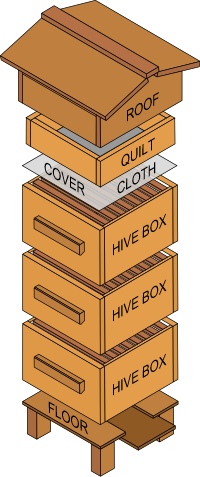Warré Top Bar Hive
Top Bar hives take many forms and their origins date back hundreds of years. The Warré hive is a top bar hive, usually referred to as ‘The People’s Hive’ in France where it was designed by Abbé Émile Warré (1867 – 1951) and described in his book Beekeeping for All.
As the hive does not use conventional frames like the other hives described so far the calculation of the number of cells available for brood in each hive box is approximate. The National hive figures are given for comparison.
As can be seen from the illustration the Warré hive consists of a tower of identical hive boxes plus floor, top bar cover cloth, quilt and roof.
The usual procedure is to introduce bees into a single box. When more space is required a second box is added below the first, called nadiring. This process can be repeated as often as required.

In each hive box there are eight top bars which are usually supplied with wax comb guides. The 24mm wide bars rest in a rebate cut into the thickness of the hive wall and are spaced 12mm apart.
The cover cloth rests on the bars in the top box and can be of hessian or other breathable cloth. Above the cloth is placed the quilt which is essentially a shallow box with a cloth base and filled with wood shavings, dried leaves etc to act as insulation.
The roof is placed over the quilt but there is no direct passage of air from the hive to the vents in the roof.
| HIVE DATA | NATIONAL 14×12 | HIVE DATA | WARRÉ |
|---|---|---|---|
| Brood frame | 14″ x 8½” | Brood box cross section | 300 x 210mm |
| Super frame | 14″ x 5½” | Honey box cross section | 300 x 210mm |
| Frames / brood box | 11 | Top bars / box | 8 |
| Cells / brood box | 54,000 | Cells / brood box | 39,000 |
| Lug length | 1½” | Lug length | Approx 1cm |
The essential feature of Warré beekeeping is to reduce disturbance and intervention to a minimum. If a hive box needs to be inspected it can be removed and tilted over with the combs in the vertical plane.
To remove a comb for inspection or honey extraction may require some cutting between walls and comb. Once free, the comb should be lifted gently and placed in a comb holder.
Warré developed his system before Varroa mites arrived in France. The consensus is that long term the bees will adapt to the mite. Mite population can be considerably reduced by artificial swarming techniques and could be further reduced by treatment while the colony is brood-less.
Honey can be collected from brood free combs by using a honey press or other suitable device. The remaining wax is a potentially valuable byproduct.
This hive is not recommended for novices unless an experienced mentor is on hand.